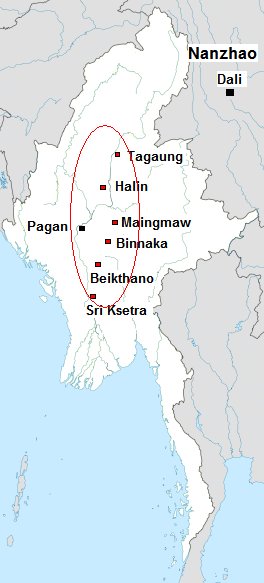|
Pyinbya
Pyinbya ( my, ပျဉ်ပြား, ; 817–876) was the king of Pagan Dynasty of Burma (Myanmar) who founded the city of Pagan (Bagan) in 849 CE. Though the Burmese chronicles describe him as the 33rd king of the dynasty founded in early 2nd century CE, modern historians consider Pyinbya one of the first kings of Pagan, which would gradually take over present-day central Burma in the next two hundred years. He was the paternal great-grandfather of King Anawrahta, the founder of Pagan Empire. Chronicle tradition According to the Burmese chronicles, the future king was born to King Saw Khin Hnit of Pagan. He was born in either 817 CE (or 802 CE).Maha Yazawin Vol. 1 2006: 346 He was lord of Pyinbya village of Pagan prior to his accession, and known as Pyinbya Mintha. He succeeded his brother King Khelu as king in 846 CE. He founded the city of Pagan on 23 December 849 (6th waxing of Pyatho 211 ME).Zata 1960: 41 He also founded a settlement of Taungdwin in 857,Hmannan Vol. 1 20 ... [...More Info...] [...Related Items...] OR: [Wikipedia] [Google] [Baidu] |
Pagan Empire
The Kingdom of Pagan ( my, ပုဂံခေတ်, , ; also known as the Pagan Dynasty and the Pagan Empire; also the Bagan Dynasty or Bagan Empire) was the first Burmese kingdom to unify the regions that would later constitute modern-day Myanmar. Pagan's 250-year rule over the Irrawaddy valley and its periphery laid the foundation for the ascent of Burmese language and culture, the spread of Bamar ethnicity in Upper Myanmar, and the growth of Theravada Buddhism in Myanmar and in mainland Southeast Asia.Lieberman 2003: 88–123 The kingdom grew out of a small 9th-century settlement at Pagan (present-day Bagan) by the Mranma/Burmans, who had recently entered the Irrawaddy valley from the Kingdom of Nanzhao. Over the next two hundred years, the small principality gradually grew to absorb its surrounding regions until the 1050s and 1060s when King Anawrahta founded the Pagan Empire, for the first time unifying under one polity the Irrawaddy valley and its periphery. By ... [...More Info...] [...Related Items...] OR: [Wikipedia] [Google] [Baidu] |
Tannet Of Pagan
Tannet ( my, တန်နက်, ; 859–904) was king of Pagan dynasty of Burma (Myanmar) from c. 876 to c. 904. A son of King Pyinbya, the founder of Pagan (Bagan), Tannet was the paternal grandfather of King Anawrahta, the founder of Pagan Empire. The king loved horses and was a master of horsemanship. He was assassinated by Sale Ngahkwe, his stable groom, who succeeded him as king.Hmannan Vol. 1 2003: 219–221 Various Burmese chronicles do not agree on the dates regarding his life and reign. The oldest chronicle ''Zatadawbon Yazawin ''Zatadawbon Yazawin'' ( my, ဇာတာတော်ပုံ ရာဇဝင်, ; also spelled ''Zatatawpon''; ) is the earliest extant chronicle of Burma. The chronicle mainly covers the regnal dates of kings as well as horoscopes of select ...'' is considered to be the most accurate for the Pagan period.(Maha Yazawin 2006: 346–349): Among the four major chronicles, only ''Zatadawbon Yazawin's'' dates line up with Anawrahta's inscrip ... [...More Info...] [...Related Items...] OR: [Wikipedia] [Google] [Baidu] |
Pagan Dynasty
The Kingdom of Pagan ( my, ပုဂံခေတ်, , ; also known as the Pagan Dynasty and the Pagan Empire; also the Bagan Dynasty or Bagan Empire) was the first Burmese kingdom to unify the regions that would later constitute modern-day Myanmar. Pagan's 250-year rule over the Irrawaddy valley and its periphery laid the foundation for the ascent of Burmese language and culture, the spread of Bamar ethnicity in Upper Myanmar, and the growth of Theravada Buddhism in Myanmar and in mainland Southeast Asia.Lieberman 2003: 88–123 The kingdom grew out of a small 9th-century settlement at Pagan (present-day Bagan) by the Mranma/Burmans, who had recently entered the Irrawaddy valley from the Kingdom of Nanzhao. Over the next two hundred years, the small principality gradually grew to absorb its surrounding regions until the 1050s and 1060s when King Anawrahta founded the Pagan Empire, for the first time unifying under one polity the Irrawaddy valley and its periphery. By t ... [...More Info...] [...Related Items...] OR: [Wikipedia] [Google] [Baidu] |
Pagan Dynasty
The Kingdom of Pagan ( my, ပုဂံခေတ်, , ; also known as the Pagan Dynasty and the Pagan Empire; also the Bagan Dynasty or Bagan Empire) was the first Burmese kingdom to unify the regions that would later constitute modern-day Myanmar. Pagan's 250-year rule over the Irrawaddy valley and its periphery laid the foundation for the ascent of Burmese language and culture, the spread of Bamar ethnicity in Upper Myanmar, and the growth of Theravada Buddhism in Myanmar and in mainland Southeast Asia.Lieberman 2003: 88–123 The kingdom grew out of a small 9th-century settlement at Pagan (present-day Bagan) by the Mranma/Burmans, who had recently entered the Irrawaddy valley from the Kingdom of Nanzhao. Over the next two hundred years, the small principality gradually grew to absorb its surrounding regions until the 1050s and 1060s when King Anawrahta founded the Pagan Empire, for the first time unifying under one polity the Irrawaddy valley and its periphery. By t ... [...More Info...] [...Related Items...] OR: [Wikipedia] [Google] [Baidu] |
Khelu
Khelu ( my, ခဲလူး; c. 794–846) was the 32nd king of Pagan Dynasty of Burma and the last king of Tampavati period of Bagan. He was the eldest son of Saw Khin Hnit and older brother of Pyinbya Pyinbya ( my, ပျဉ်ပြား, ; 817–876) was the king of Pagan Dynasty of Burma (Myanmar) who founded the city of Pagan (Bagan) in 849 CE. Though the Burmese chronicles describe him as the 33rd king of the dynasty founded in early 2n .... He reigned over Bagan for 17 years. After his death, he was succeeded by his brother, Pyinbya. {{DEFAULTSORT:Khelu Pagan dynasty 790s births 846 deaths Year of birth uncertain 9th-century Burmese monarchs ... [...More Info...] [...Related Items...] OR: [Wikipedia] [Google] [Baidu] |
List Of Burmese Monarchs
This is a list of the monarchs of Burma (Myanmar), covering the monarchs of all the major kingdoms that existed in the present day Burma (Myanmar). Although Burmese chronicles, Burmese chronicle tradition maintains that various monarchies of Burma (Mon people, Mon, Bamar people, Burman, Rakhine people, Arakanese), began in the 9th century Common Era, BCE, historically verified data date back only to 1044 CE at the accession of Anawrahta of Pagan dynasty, Pagan. The farther away the data are from 1044, the less verifiable they are. For example, the founding of the city of Pagan (Bagan) in the 9th century is verifiable–although the accuracy of the actual date, given in the Chronicles as 849, remains in question–but the founding of early Pagan dynasty, given as the 2nd century, is not.Harvey 1925: 364 For early kingdoms, see List of early and legendary monarchs of Burma. The reign dates follow the latest available dates as discussed in each section. Early kingdoms * See List of ... [...More Info...] [...Related Items...] OR: [Wikipedia] [Google] [Baidu] |
Hmannan Yazawin
''Hmannan Maha Yazawindawgyi'' ( my, မှန်နန်း မဟာ ရာဇဝင်တော်ကြီး, ; commonly, ''Hmannan Yazawin''; known in English as the '' Glass Palace Chronicle'') is the first official chronicle of Konbaung Dynasty of Burma (Myanmar). It was compiled by the Royal Historical Commission between 1829 and 1832.Hla Pe 1985: 39–40 The compilation was based on several existing chronicles and local histories, and the inscriptions collected on the orders of King Bodawpaya, as well as several types of poetry describing epics of kings. Although the compilers disputed some of the earlier accounts, they by and large retained the accounts given ''Maha Yazawin'', the standard chronicle of Toungoo Dynasty. The chronicle, which covers events right up to 1821, right before the First Anglo-Burmese War (1824–1826), was not written purely from a secular history perspective but rather to provide "legitimation according to religious criteria" of the monarchy. ... [...More Info...] [...Related Items...] OR: [Wikipedia] [Google] [Baidu] |
Zatadawbon Yazawin
''Zatadawbon Yazawin'' ( my, ဇာတာတော်ပုံ ရာဇဝင်, ; also spelled ''Zatatawpon''; ) is the earliest extant chronicle of Burma. The chronicle mainly covers the regnal dates of kings as well as horoscopes of select kings from Pagan to Konbaung periods. In terms of regnal years, the chronicle is considered "the most accurate of all Burmese chronicles, particularly with regard to the best-known Pagan and Ava kings, many of whose dates have been corroborated by epigraphy."Aung-Thwin 2005: 121–123 History The chronicle was continuously updated and handed down by court historians from generation to generation.Htin Aung 1970: 41 Given its inscriptionally verified regnal dates of 11th century Pagan kings, the list keeping of regnal dates probably had begun at least since the 11th century, if not earlier. The earliest portions of the chronicle appear to have written sometime in the late 13th century or the early 14th century. The original author is unknow ... [...More Info...] [...Related Items...] OR: [Wikipedia] [Google] [Baidu] |
817 Births
__NOTOC__ Year 817 ( DCCCXVII) was a common year starting on Thursday (link will display the full calendar) of the Julian calendar. Events By place Europe * Summer – Emperor Louis I issues an ''Ordinatio Imperii'', an imperial decree that lays out plans for an orderly succession. He divides the Frankish Empire among his three sons: Lothair, the eldest, is proclaimed co-emperor in Aachen, and becomes the overlord of his brothers. He receives the dominion of Burgundy (including German and Gallic parts). Pepin, the second son, is proclaimed king of Aquitaine, and receives Gascony (including the marche around Toulouse and parts of Septimania); Louis (the youngest son) is proclaimed king of Bavaria, and receives the dominions of East Francia. * Prince Grimoald IV is assassinated by a complot of Lombard nobles vying for his throne.Wickham, p. 154. In 818 according to the ''Annales Beneventani''. He is succeeded by Sico as ruler of Benevento ( Southern Italy) ... [...More Info...] [...Related Items...] OR: [Wikipedia] [Google] [Baidu] |
Yazawin Thit
''Maha Yazawin Thit'' ( my, မဟာ ရာဇဝင် သစ်, ; ; also known as ''Myanmar Yazawin Thit'' or ''Yazawin Thit'') is a national chronicle of Burma (Myanmar). Completed in 1798, the chronicle was the first attempt by the Konbaung court to update and check the accuracy of ''Maha Yazawin'', the standard chronicle of the previous Toungoo Dynasty. Its author Twinthin Taikwun Maha Sithu consulted several existing written sources, and over 600 stone inscriptions collected from around the kingdom between 1783 and 1793.Thaw Kaung 2010: 44–49 It is the first historical document in Southeast Asia compiled in consultation with epigraphic evidence.Woolf 2011: 416 The chronicle updates the events up to 1785, and contains several corrections and critiques of earlier chronicles. However, the chronicle was not well received, and ultimately rejected by the king and the court who found the critiques of earlier chronicles excessively harsh.Thaw Kaung 2010: 50–51 It became kn ... [...More Info...] [...Related Items...] OR: [Wikipedia] [Google] [Baidu] |
876 Deaths
__NOTOC__ Year 876 ( DCCCLXXVI) was a leap year starting on Sunday (link will display the full calendar) of the Julian calendar. Events By place Byzantine Empire * At the invitation of Benevento, the newly-restored Byzantine fleet appears in the waters off Otranto. On the orders of Emperor Basil I, the Byzantines sail up the Adriatic Sea and reconquer part of southern Italy. The city of Bari is occupied in the name of the Byzantine Empire. Instead of holding it for his 'ally' Adelchis of Benevento, Basil makes it the capital of the new Byzantine Theme of Longobardia. Europe * August 28 – King Louis the German dies at Frankfurt, while preparing for war against his brother Charles II ("the Bald"), ruler of the Holy Roman Empire. The East Frankish Kingdom is divided among his three sons: Carloman receives Bavaria and styles himself "King of Bavaria". Louis the Younger receives Saxony (with Franconia and Thuringia), and Charles the Fat receives Swabia (with Ra ... [...More Info...] [...Related Items...] OR: [Wikipedia] [Google] [Baidu] |
Bagan
Bagan (, ; formerly Pagan) is an ancient city and a UNESCO World Heritage Site in the Mandalay Region of Myanmar. From the 9th to 13th centuries, the city was the capital of the Bagan Kingdom, the first kingdom that unified the regions that would later constitute Myanmar. During the kingdom's height between the 11th and 13th centuries, more than 10,000 Buddhist temples, pagodas and monasteries were constructed in the Bagan plains alone, of which the remains of over 2200 temples and pagodas survive. The Bagan Archaeological Zone is a main attraction for the country's nascent tourism industry. Etymology Bagan is the present-day standard Burmese pronunciation of the Burmese word ''Pugan'' ( my-Mymr, ပုဂံ), derived from Old Burmese ''Pukam'' ( my-Mymr, ပုကမ်). Its classical Pali name is ''Arimaddanapura'' ( my-Mymr, အရိမဒ္ဒနာပူရ, lit. "the City that Tramples on Enemies"). Its other names in Pali are in reference to its extreme dry zone cl ... [...More Info...] [...Related Items...] OR: [Wikipedia] [Google] [Baidu] |




